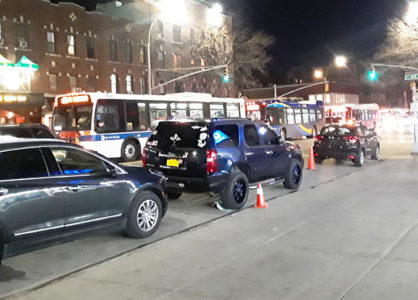City officials on Tuesday, November 1 gave the public a closer look at the Brooklyn Queens Connector (BQX) – a streetcar system that will connect the two boroughs – by unveiling a number of different options currently being weighed for the project, including potential routes.
The light rail line — proposed by Mayor Bill de Blasio during his State of the City address earlier this year — is the brainchild of the Friends of the Brooklyn Queens Connector (BQX) — a nonprofit organization consisting of transit experts, real estate developers and other businesspeople.
The streetcar line – which, officials say, will include over 30 stops, each less than a mile apart — will stretch over 15 miles from Sunset Park to Astoria, with the hopes of connecting the new system to the MTA’s new fare payment technology, currently under development.
Furthermore, officials said, a second goal of the BQX is to connect to key subway stations like Jay Street-Metrotech, Borough Hall, and Court Street.
According to a newly released 25-page report, the $2.5 billion project would run on streets in some of the city’s most populated neighborhoods along the East River, including Williamsburg, Greenpoint and Downtown Brooklyn.
Other Brooklyn neighborhoods with stops on the streetcar will include Fort Greene, Clinton Hill, Cobble Hill and Red Hook.
In Sunset Park, Fourth, Third and Second Avenues are in the running for the streetcar’s route, with a potential terminal to be placed in the vicinity of the Brooklyn Army Terminal.
Options for Downtown Brooklyn include Atlantic Avenue, Court Street, Joralemon Street and Adams Street/Boerum Place. Meanwhile, officials are considering Columbia, Mill and Van Brunt/Richards Streets for Red Hook, with a possible crossing over the Gowanus Canal which would happen either over the 10th Street Bridge or the 19th Street Bridge.
City officials plan to discuss the routes at community meetings over the next two months, with the ultimate goal of selecting a path early next year. Furthermore, the city could begin the project’s environmental review in 2017, with construction to start as early as 2019.

 Heavy winds create Verrazzano traffic nightmare
Heavy winds create Verrazzano traffic nightmare  Morning bus layover proposed at busy S79 stop
Morning bus layover proposed at busy S79 stop
Let’s see that the BQX could have more than enough riders to meet the overall operating costs and time will tell. I will be cautiously skeptical about this.